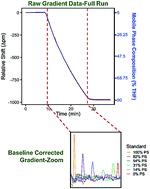Our official English website, www.x-mol.net, welcomes your
feedback! (Note: you will need to create a separate account there.)
A linear mass concentration detector for solvent gradient polymer separations.
Analyst ( IF 3.6 ) Pub Date : 2020-05-12 , DOI: 10.1039/c9an02533b Emily H Mordan 1 , James H Wade , Eric Pearce , David M Meunier , Ryan C Bailey
Analyst ( IF 3.6 ) Pub Date : 2020-05-12 , DOI: 10.1039/c9an02533b Emily H Mordan 1 , James H Wade , Eric Pearce , David M Meunier , Ryan C Bailey
Affiliation

|
Characterization of copolymers requires the measurement of two distributions—molecular weight (MW) and chemical composition (CC). Molecular weight distributions (MWD) are traditionally determined using size exclusion chromatography (SEC) run under isocratic solvent conditions. Chemical composition distributions (CCD) are often determined using liquid adsorption chromatography (LC) with solvent gradients. The use of solvent gradients, however, often limits options of compatible detectors. A gradient compatible, universal linear mass concentration detector is a longstanding unmet need. Many industrially-relevant polymers lack chromophores or other discriminating moieties requiring detectors with a universal response. Differential refractive index (dRI) is incompatible with gradient elution due to its small dynamic range. Charged aerosol detectors (CAD) and evaporative light scattering detectors (ELSD) are probably the most promising options for gradient elution detection, but both suffer from a nonlinear mass concentration response. Silicon photonic microring resonators are optical sensors that are responsive to changes in the local refractive index (RI). The substantial dynamic range of this technology makes it attractive for refractive index-based detection during solvent gradient elution. Previously, the microring resonator platform was used as a SEC detector to characterize the MWD of broadly dispersed polystyrene (PS) standards. In this study, we demonstrate the gradient compatibility of the microring resonator platform for polymer detection by quantifying the CCD of polymer blend components. Control experiments were run with UV and ELSD detection, highlighting the uniqueness of the platform as a linear mass concentration detector with a universal detector response.
中文翻译:

用于溶剂梯度聚合物分离的线性质量浓度检测器。
共聚物的表征需要测量两个分布-分子量(MW)和化学组成(CC)。分子量分布(MWD)通常使用在等度溶剂条件下进行的尺寸排阻色谱(SEC)确定。通常使用具有溶剂梯度的液相吸附色谱法(LC)确定化学成分分布(CCD)。但是,使用溶剂梯度通常会限制兼容检测器的选择。梯度兼容的通用线性质量浓度检测器是长期未满足的需求。许多与工业相关的聚合物缺乏发色团或其他区分部分,因此要求检测器具有通用响应。微分折射率(dRI)的动态范围小,因此与梯度洗脱不兼容。带电气溶胶检测器(CAD)和蒸发光散射检测器(ELSD)可能是梯度洗脱检测的最有前途的选择,但它们都具有非线性质量浓度响应的问题。硅光子微环谐振器是对局部折射率(RI)的变化做出响应的光学传感器。该技术的巨大动态范围使其在溶剂梯度洗脱过程中对基于折射率的检测具有吸引力。以前,微环谐振器平台用作SEC检测器来表征广泛分散的聚苯乙烯(PS)标准品的MWD。在这项研究中,我们通过量化聚合物共混物组分的CCD展示了用于聚合物检测的微环共振器平台的梯度相容性。使用UV和ELSD检测进行对照实验,
更新日期:2020-06-29
中文翻译:

用于溶剂梯度聚合物分离的线性质量浓度检测器。
共聚物的表征需要测量两个分布-分子量(MW)和化学组成(CC)。分子量分布(MWD)通常使用在等度溶剂条件下进行的尺寸排阻色谱(SEC)确定。通常使用具有溶剂梯度的液相吸附色谱法(LC)确定化学成分分布(CCD)。但是,使用溶剂梯度通常会限制兼容检测器的选择。梯度兼容的通用线性质量浓度检测器是长期未满足的需求。许多与工业相关的聚合物缺乏发色团或其他区分部分,因此要求检测器具有通用响应。微分折射率(dRI)的动态范围小,因此与梯度洗脱不兼容。带电气溶胶检测器(CAD)和蒸发光散射检测器(ELSD)可能是梯度洗脱检测的最有前途的选择,但它们都具有非线性质量浓度响应的问题。硅光子微环谐振器是对局部折射率(RI)的变化做出响应的光学传感器。该技术的巨大动态范围使其在溶剂梯度洗脱过程中对基于折射率的检测具有吸引力。以前,微环谐振器平台用作SEC检测器来表征广泛分散的聚苯乙烯(PS)标准品的MWD。在这项研究中,我们通过量化聚合物共混物组分的CCD展示了用于聚合物检测的微环共振器平台的梯度相容性。使用UV和ELSD检测进行对照实验,











































 京公网安备 11010802027423号
京公网安备 11010802027423号